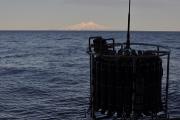Tracers - a podcast by The University of Texas Marine Science Institute
from 2022-04-12T21:28:33.764390

Scientists learn a lot about the oceans by measuring a pinch of this and a smidge of that. These tiny amounts can help trace ocean currents, determine the abundance of microscopic life, measure pollution, plot past changes in the climate, and find out how the current climate is changing.
Scientists are learning all of that and more from Geotraces, an international program that samples the water from all the oceans. Since the start of the program in 2010, scientists from about 35 countries have logged tens of thousands of miles in research cruises.
They send down sets of “bottles” that sample the water at different depths. The bottles have to be handled carefully to make sure there’s no contamination from the ship or crew. That’s because the project is tracing tiny amounts of many elements -- concentrations of a few parts per million or even billion. And each of those elements is important.
Iron, for example, is a key nutrient for microscopic organisms. Scientists can measure different forms of iron to tell where the water came from, which helps find regions of the oceans that are the most productive. Beryllium helps trace the origins of other nutrients that are blown around the globe with dust. And different concentrations of a rare element known as neodymium can trace water in the Arctic to its origin in Siberian rivers.
So following these and dozens of other elements is helping scientists piece together important stories about the oceans -- one pinch at a time.
Further episodes of Science and the Sea podcast
Further podcasts by The University of Texas Marine Science Institute